- MathNotebook
- MathConcepts
- StudyMath
- Geometry
- Logic
- Bott periodicity
- CategoryTheory
- FieldWithOneElement
- MathDiscovery
- Math Connections
Epistemology
- m a t h 4 w i s d o m - g m a i l
- +370 607 27 665
- My work is in the Public Domain for all to share freely.
- 读物 书 影片 维基百科
Introduction E9F5FC
Questions FFFFC0
Software
Presented at Space and Time: An Interdisciplinary Approach, September 29-30, 2017 in Vilnius, Lithuania.
Audio of presentation and discussion
Time and Space as Representations of Decision-Making
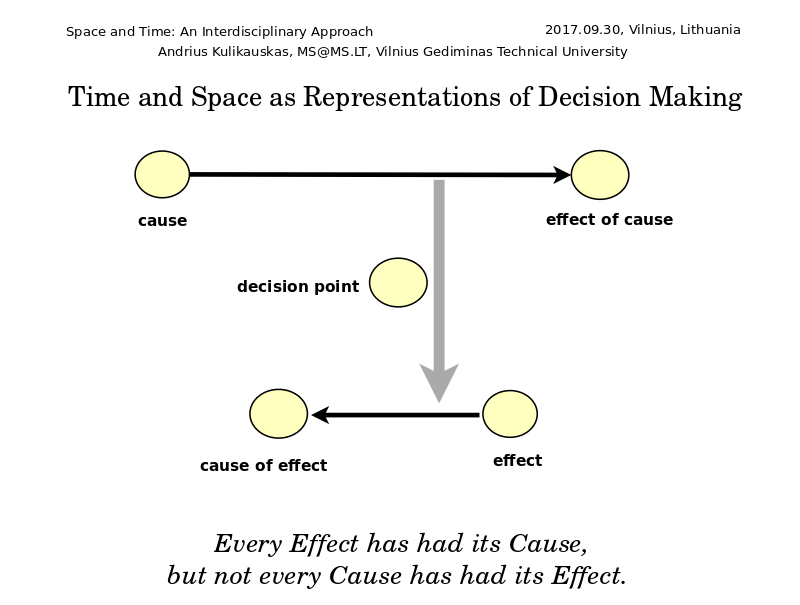
By what conceptual framework do we experience time and space? I investigate this question by pursuing metaphysics as a cognitive science. I take our imagination's limitations as the pragmatic ground for absolute truth, document the perspectives available to us on particular issues, and develop testable models of cognitive frameworks for those issues.
I present a model in which our minds construct time and space as representations of decision-making. Both time and space suppose five perspectives which define two directions for causality: "Every effect has had its cause" but also "Not every cause has had its effects". Time expresses causality dynamically from past to future. In time, the present is given by an ambiguity between the forwards direction of time, from cause to effect, and the backwards direction of time, from effect to cause. Space expresses causality statically as an outer system determining an inner subsystem. In space, the boundary disambiguates the outer cause and the inner effect.
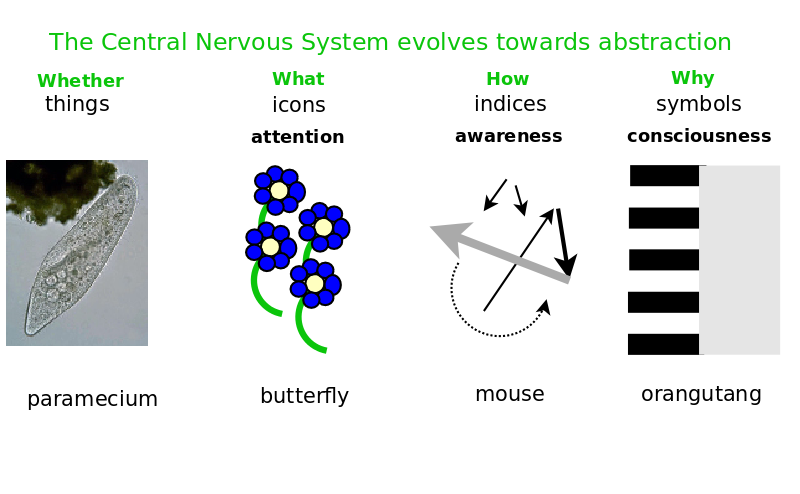
I will make my approach more plausible for materialists by noting how the central nervous system evolves towards abstraction. A single-celled paramecium engages the world directly by way of its receptors for light and chemicals. But a butterfly lives in a world of flowers, that is, a neural representation of the world in terms of sensorial images which it pays attention to. As neuroscientist Michael Graziano has noted, a mouse furthermore has awareness, in that it utilizes a model of attention which it can identify not only with its own attention, and thus be itself aware, but likewise model a cat's attention, and thus be aware of whether or not the cat is attending to the mouse. Thus the mouse lives an abstract world of indexical and causal relationships.
But humans and perhaps the great apes can moreover be conscious, that is, we can choose what we wish to be aware of. Birute Galdikas has noted how orangutang males go off to live alone, as if they were Zen Buddhists, and how they can choose to ignore people or not. We humans can choose to "step in" and immerse ourselves in a subjective experience, or to "step out" and consider objectively what is going on, what others are experiencing. I will describe us as experiencing cognitive frameworks by which we divide up what neuroscientists call our global workspace into various perspectives they may take up for a particular issue, for example, contemplating "free will" and "fate". Indeed, I will describe our conscious life as shifting amongst eight such cognitive frameworks. They substitute our world with a highly constrained abstract model of options within which we adjust parameters that subsequently trigger the workings of our involuntary, unconscious mind.
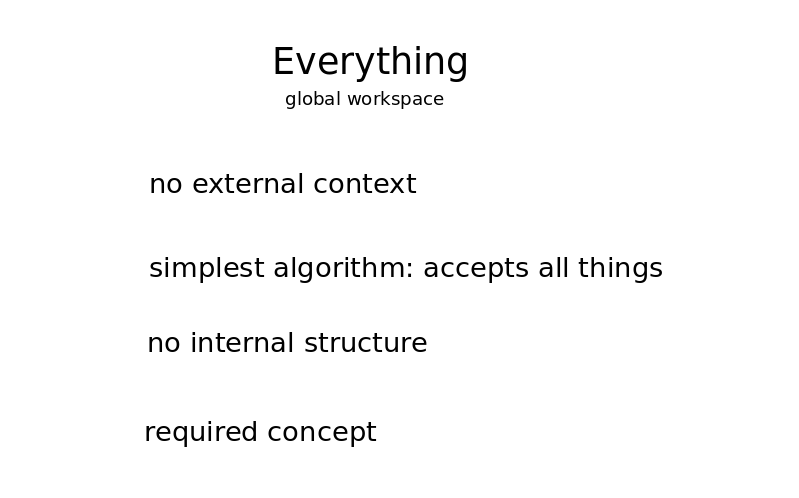
What neuroscientists call the global workspace, I believe we experience intuitively as the familiar concept of everything. We can define everything by noting its four remarkable properties:
- Everything has no external context. If you put it in a box, then it includes the box. If you think it, it includes you.
- Everything has no internal structure. It can be chaotic or orderly. Thus, all statements are true about everything, for there is no structure to hold onto: Everything is hot, everything is cold, everything is good, everything is bad.
- Everything is the simplest possible algorithm, the one which has no filter but accepts all things, whatever we think of. This means that we all have the same Everything, although we may call it by different names, such as Being, Love, Meaning and so on.
- Everything is a required concept. We all have it, and appeal to it, for example, when we take a stand, which we do with regard to everything. We could not have learned of Everything, because all that we know is bounded, but Everything is unbounded. We cannot rid ourselves of it as a concept. It must have always been with us.
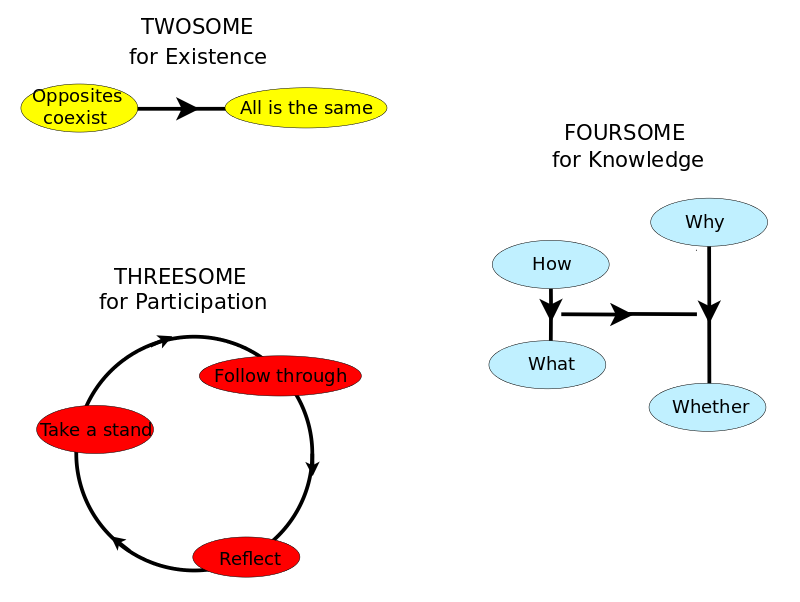
In considering a particular issue, we divide everything into perspectives. For example, matters of existence require two points of view: We need to be able to raise a question, does a chair exist or not? but also suppose an answer: If it exists, then it exists; if not, then not. Similarly, questions of participation require three points of view: a cycle of taking a stand, following through, and reflecting. Such a cycle is the basis for the scientific method: having a hypothesis, conducting an experiment, and intepreting the results.
Issues of knowledge require four points of view: whether, what, how and why. We experience a cup as a sensory image, What, but also as a mental blueprint, How. We may furthermore imagine Whether the cup is in a cupboard even when nobody sees it. And when we imagine Why there is a cup, then we suppose that we must know its relationships with absolutely everything.
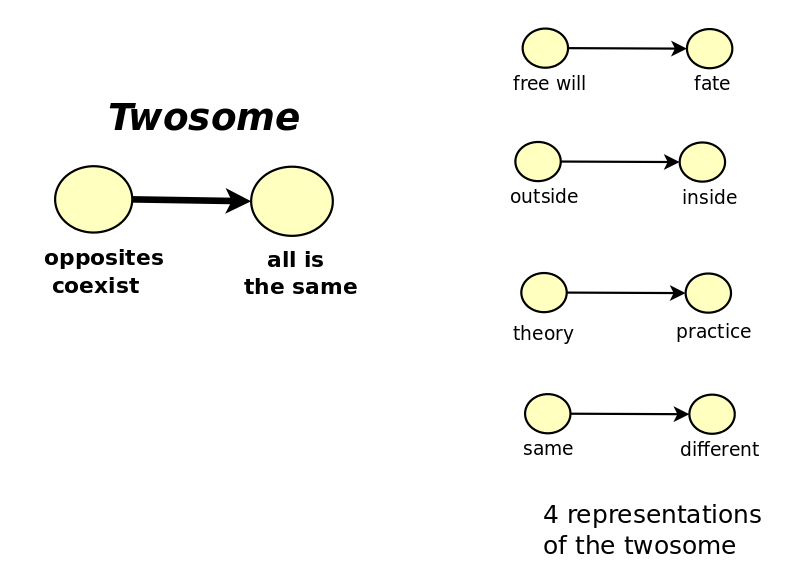
In documenting such frameworks, I introspect my own imagination's options. I also note how I conceive the same cognitive frameworks by different representations, which are manifestly limited in their variety. Indeed, our minds do not conceive the division directly but must employ one or another representation.
For example, I can imagine the perspective of opposites coexisting as "free will" and the perspective of all being the same as "fate". Indeed, classic, intractable debates such as "free will vs. fate" are important evidence for these frameworks. Throughout history, different philosophers describe similar frameworks in their own terms.
Another representation is in terms of outside and inside. If there is an an outside of a cup, then there is also an inside. But if I fall inside the cup - if it becomes my universe - then there is only an inside. Note also that our mind slides easily from outside to inside, or from free will to fate, but not the other way around.
A third representation is in terms of theory and practice. In theory, I am detached from what I am studying, as if it were a machine that is turned off. But in practice, the machine is turned on, I am one with my experience, like a carrot going through a mill. We complement each other and are one.
Same and different are a fourth and final representation. If two cups are the same, then they must also be different. But if they are different, then they are just different. Here it is remarkable that the concept of sameness actually involves opposites coexisting, whereas the concept of difference means that all is the same. This illustrates the pitfalls of introspection because adding a layer of reflection typically reverses the direction in which our minds move.
As you will see, additional evidence for these divisions and their representations is that they serve as building blocks for more elaborate frameworks, and also ever reappear in classifying the basic frameworks.
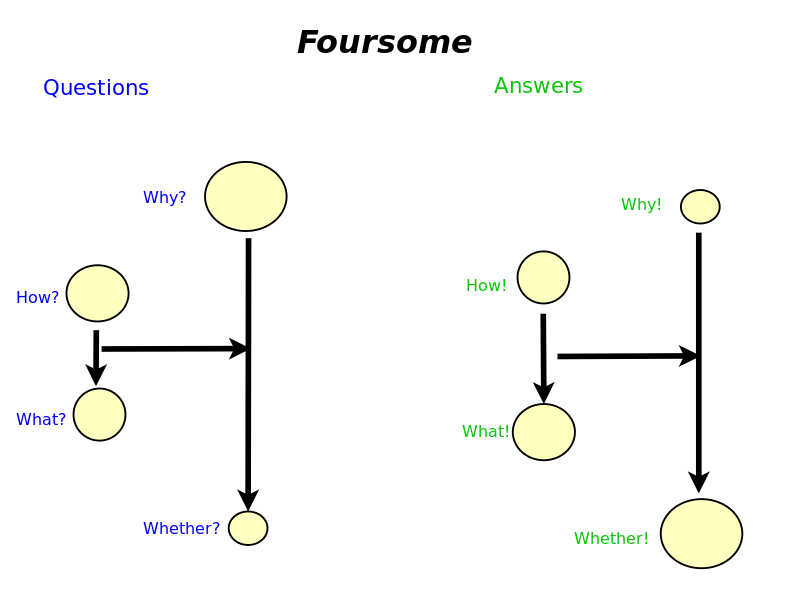
The Foursome, the framework for knowledge, has two representations. Idealists consider the observer's perspective, their questions, and consider Why most important and dismiss Whether as irrelevant. Materialists think in terms of answers, the observed's point of view, and so for them Whether is most real and they would eliminate Why. Kant understandably tried to straddle both points of view. The semiotician Peirce distinguished three kinds of signs. Icons leverage Whatness, indices leverage Howness and symbols leverage Whyness, but we should additionally consider the Whetherness of the signified thing itself.
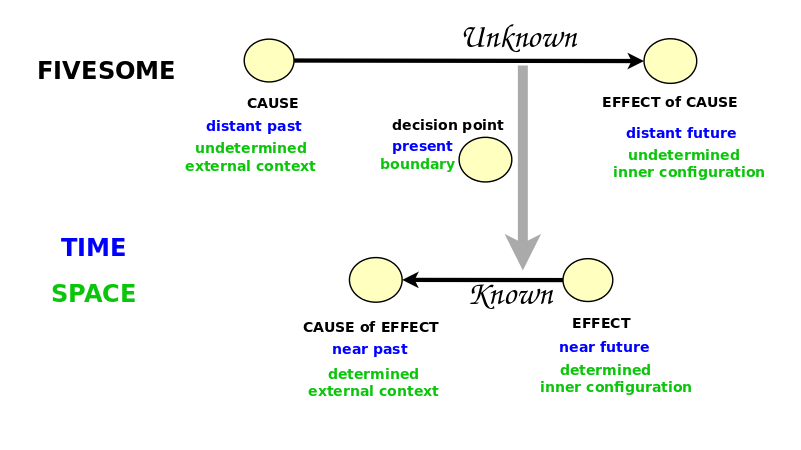
This attempt to document our imagination's options simply and absolutely and thereby model everything forces an economy which encourages us to consider whether time and space are simply two representations of a shared cognitive framework, namely, for decision making.
We experience time in two very different modes. We can be focused on the near past and the near future, looking slightly ahead and slightly behind, immersed in life's obligations. But in order to live the present, we need to make room for it by pushing our past back, to our values, which we may imagine as existing prior to us, and pushing our future forward, to our dreams, which may perhaps be fulfilled after we are gone. And so we create a gap that severs any practical link between long ago causes and far off effects.
Such a model distinguishes two directions in time with which we are familiar. "Every effect has had its cause" and so, practically and personally, our mind readily jumps backwards to identify causal chains. But "Not every cause has had its effects" and so, theoretically and impersonally, we imagine time marching forwards through a sequence of discrete events. Those events are defined by imagining them in the present, where both directions are available to us.
We can argue a similar model for space if we note that statically causes are ultimately external to a system whereas effects are internal to it. However, we will suggest later that in space, the boundary disambiguates the outer system and the inner subsystem, whereas in time, the present overlaps our experience of causality in the forwards and backwards directions.
Any attempts to cognitively model time and space in terms of discrete perspectives will thus have to explain how we construct what we experience as a continuum even if we might suppose that such a continuum exists. And we construct that experience by jumping around between different perspectives, both forward looking and backwards looking, rather than experience them as a continuous flow, as we have been taught to imagine.
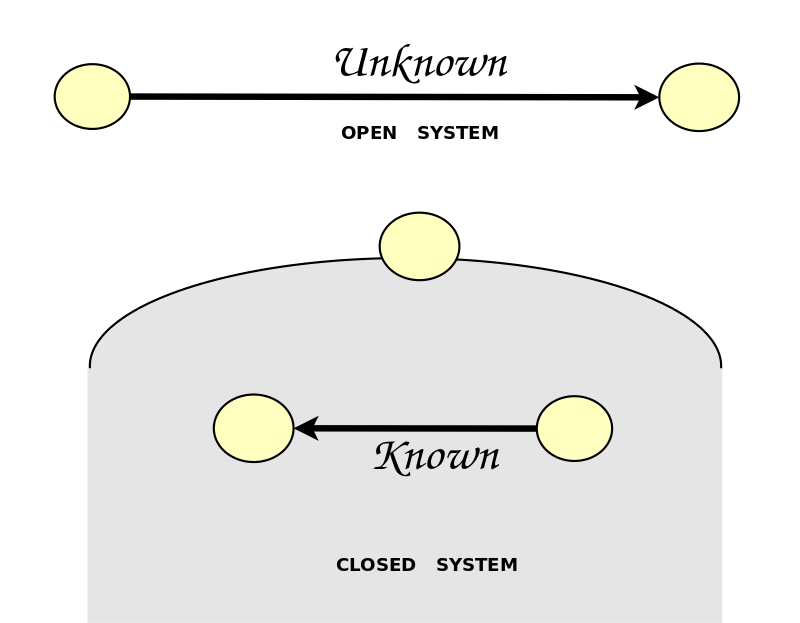
Decision-making is the cognitive activity which thereby has us circumscribe our decision point, either the present in time or the boundary in space, by which what is unknown, impersonal and theoretical becomes known, personal and practical.
Decision-making models causality by approximating the unknown with the known. It thereby fosters the ambiguity, which we experience in the present, and which arises in the study of entropy, as to whether we live in an open system or a closed system. It also relates our practical, singleminded, unconscious mind, full of knowledge, with our theoretical, multitrack, conscious mind which is able to contemplate not knowing but rather framing questions into perspectives which the unconscious mind takes up.
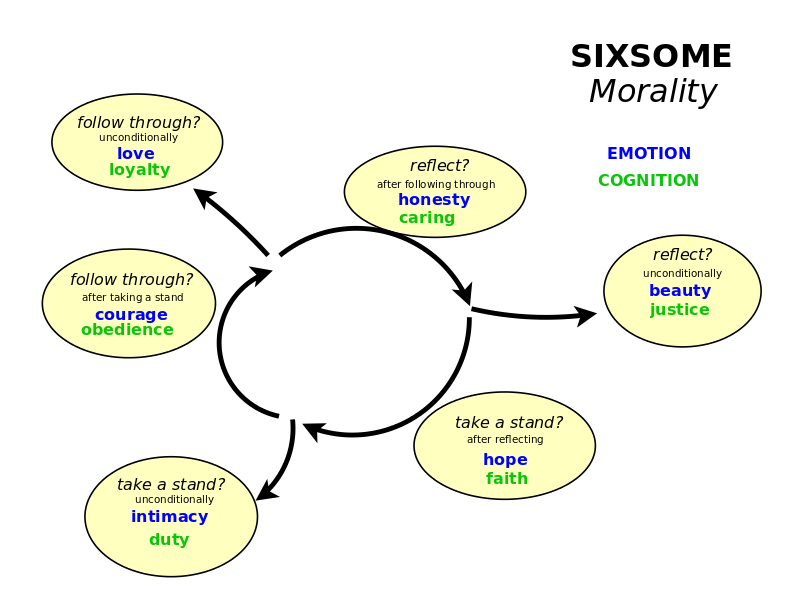
In surveying these frameworks, I note that there is a sixsome for issues of morality. One representation, in terms of cognition, is spatial in that it has us internalize outer perspectives, such as loyalty, into inner perspectives, such as faith. Another representation, in terms of emotion, is temporal in that it has us immortalize our positive but fleeting emotions, such as beauty, as virtues of our character, such as courage.
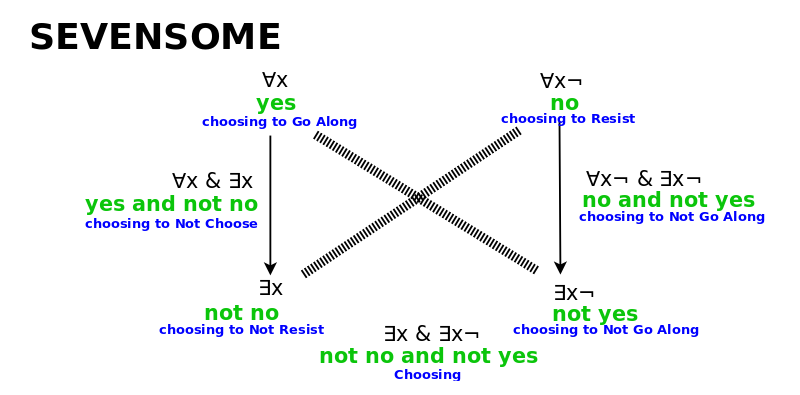
Finally, the sevensome establishes the logical square which we need for a self-standing system, including the ability to divide and thus define opposites such as true and false or good and bad. The slack in this system is represented as either increasing, as with the present in time, or decreasing, as with the boundary in space.
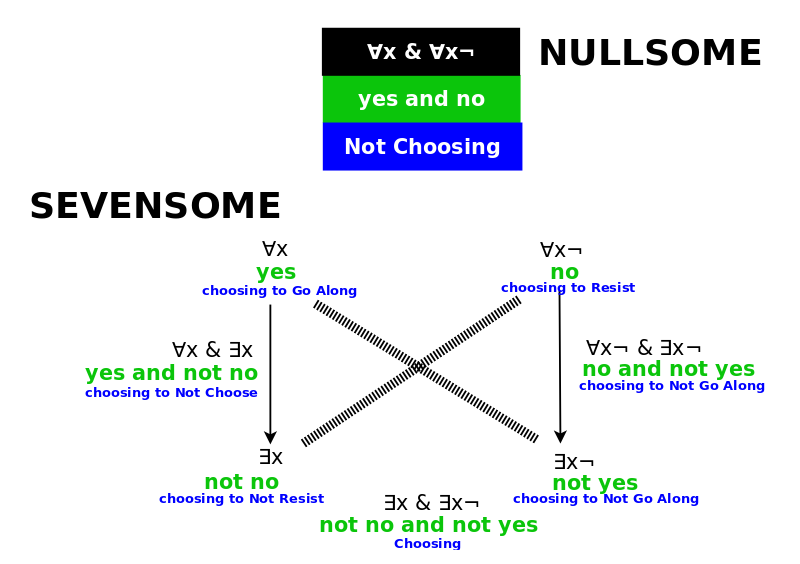
An eighth perspective would include the possibility "all are true and all are false", in which case the system is empty, it collapses and we have the Nullsome, the division of everything into no perspectives, by which we contemplate issues of God.
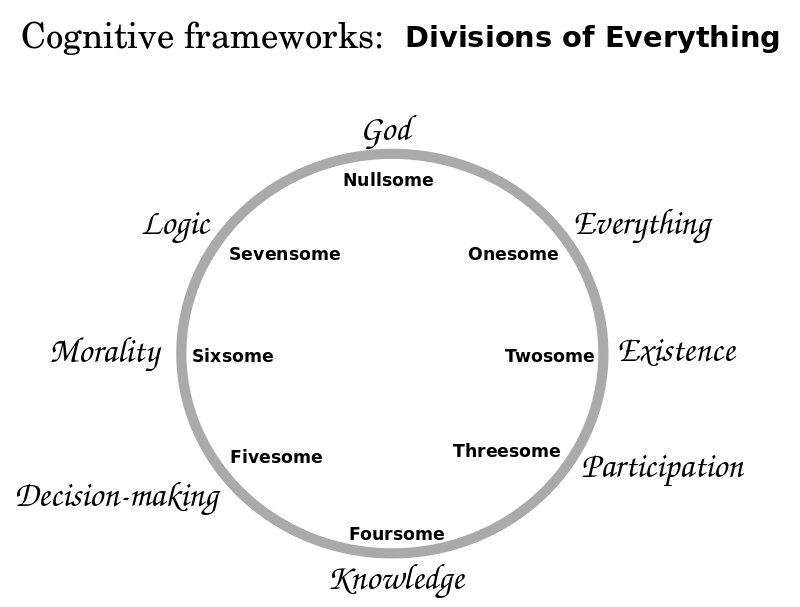
I have thus surveyed eight cognitive frameworks, divisions of everything, which I believe fully describe our conscious experience as a series of philosophical issues that we grapple with. I imagine that we contemplate them even in the womb, and perhaps orangutangs may likewise, and truly any system such as a cloud or galaxy tends toward the same set of options by which its conscious side may govern its unconscious side.
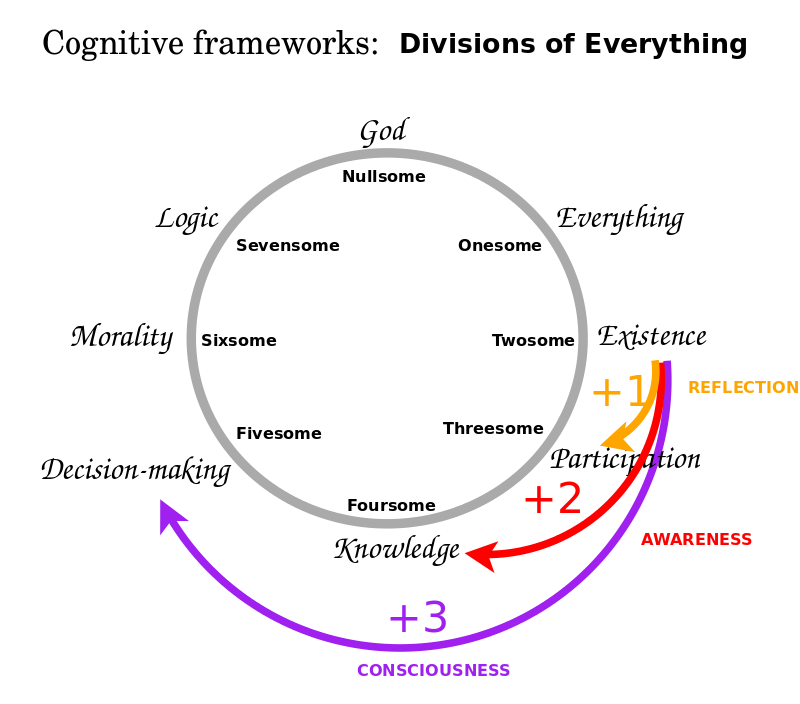
We can then model human reflection, awareness and consciousness, shifting our minds from issue to issue, adding one, two or three perspectives to each frameworks. I will interpret several equations that bear on our experience of time and space.
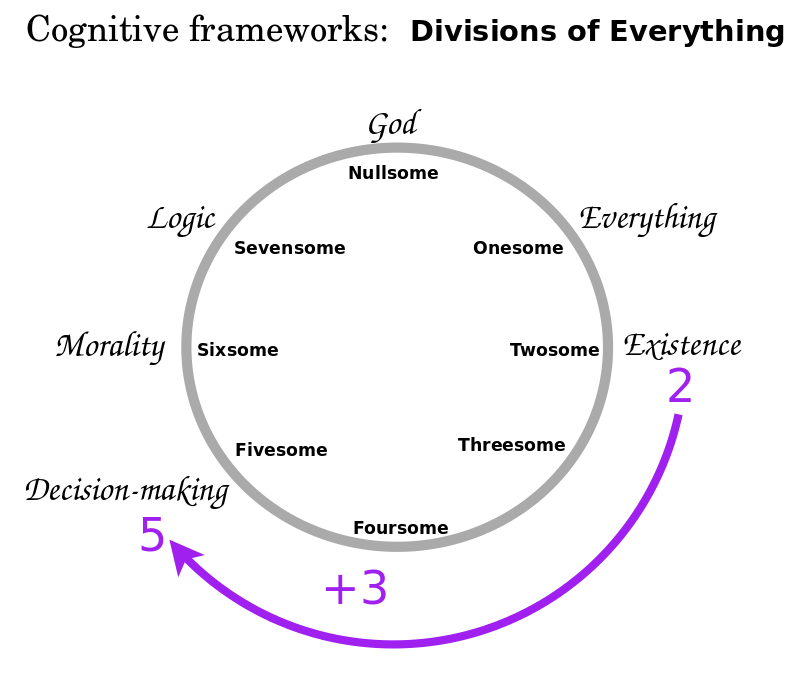
Suppose that we are engaged with issues of existence and then we become conscious of that. I will describe how our consciousness adds three perspectives so that we are now engaged with issues of decision-making.
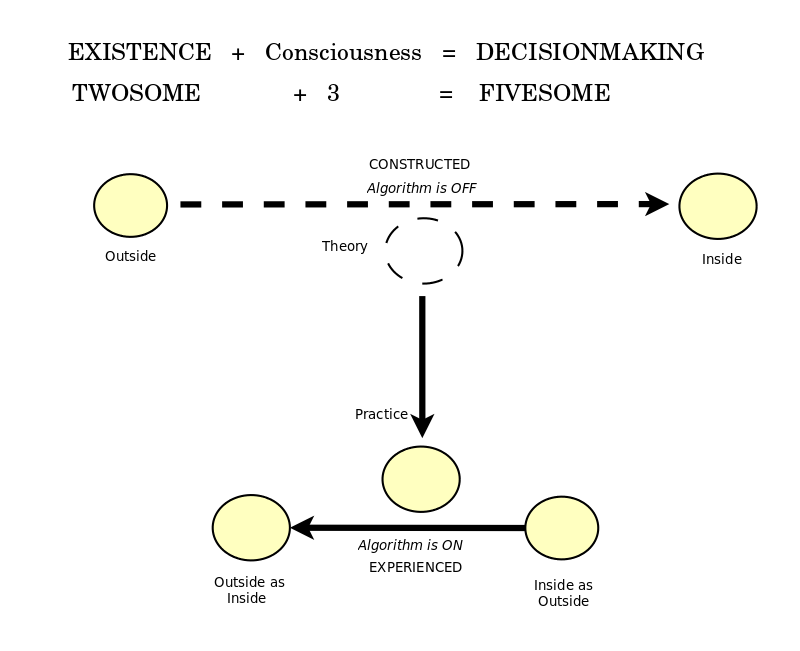
Here I will model consciousness as the ability to turn our awareness on or off. So let us conceive of the issue of existence as an algorithm, procedure or machine. Such is the representation which takes us from outside to inside. In theory, the machine is off, and then in practice, the machine is on. Thus we can combine two versions of this machine, where our mind slides from theory to practice. Note, however, that we don't ourselves experience the theoretical perspective but rather it simply keeps our outside view from becoming an inside view. Whereas we do experience the practical perspective because it has our outside view be one and the same.
Thus we see that decision-making has a causal flow from outside to inside, in the sense of How, functionality, but also a flow from theory to practice, in the sense of What seems. Here the decision point finds itself very much in the realm of practical experience. We experience the present as our ability to turn existence on, that is, to engage theory as practice.
Note also that, in that realm of practical experience, our mental direction reverses direction for we have inverted our situation, and have started from the inside of the machine as our outside, and we experience the outside as our inside.
Finally, we see that beyond our five perspectives there has opened up, in theory, a sixth slot in which we can hold, entertain and suppose a concept which we yet do not ourselves conceive.
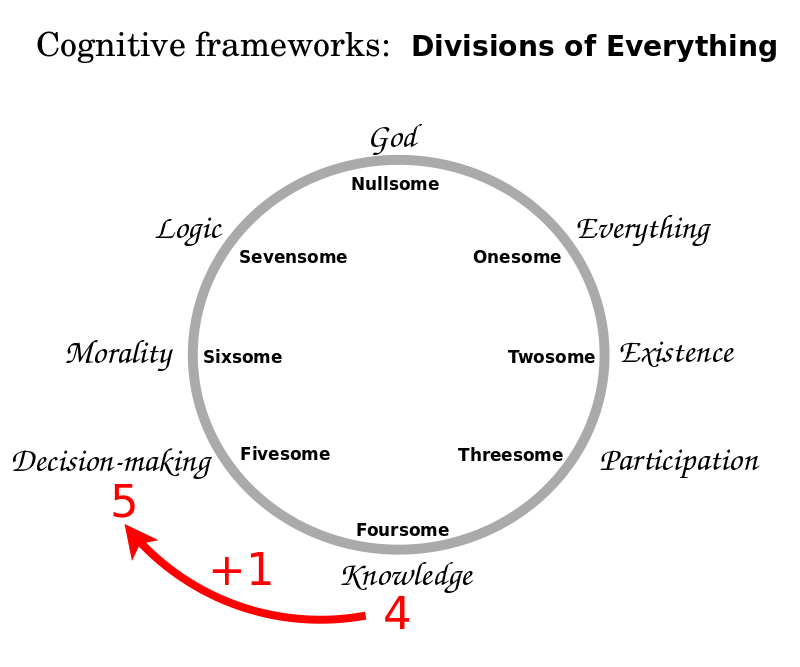
Suppose that we are engaged with issues of knowledge and then reflect on that. Our mind adds one perspective to the foursome to yield the fivesome.
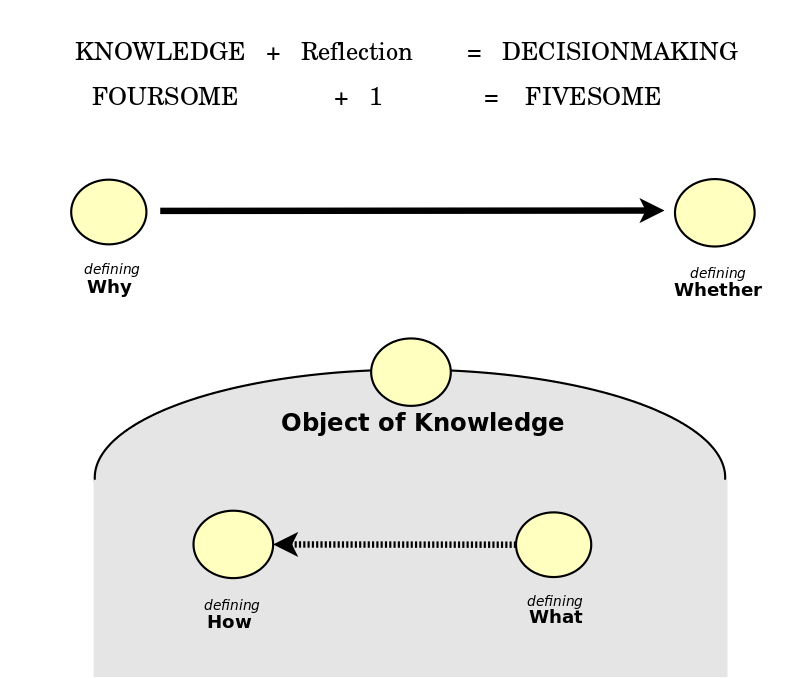
Here we consider our levels of knowledge - Whether, What, How, Why - as all bearing upon an object of knowledge. Thus we dedicate a new perspective to express that commonality which they share. Our experience of this object of knowledge circumscribes our decision point. And it defines the scope of our present in time or our boundary in space as comprising exactly one unit of knowledge. Thus we experience the present as a unit of knowledge.
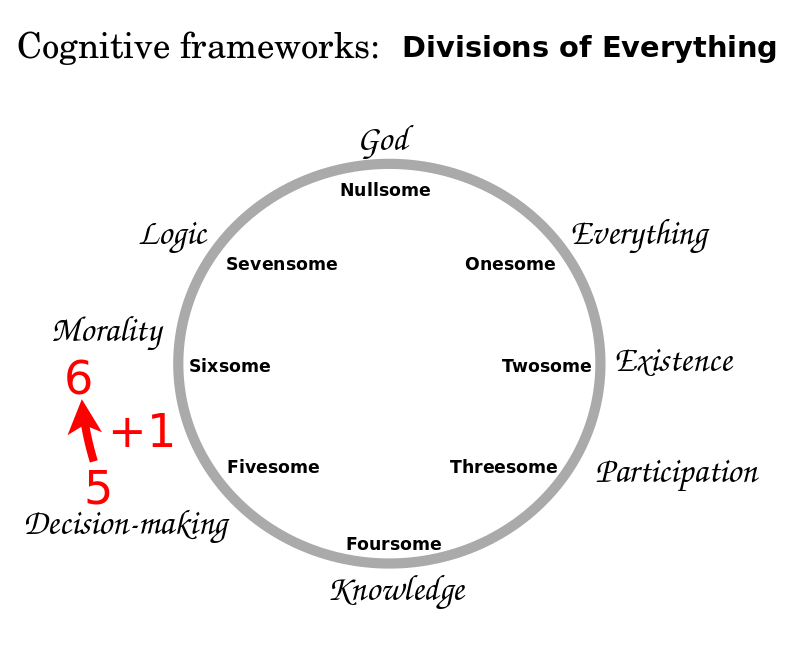
A further step of reflection takes us from decision-making to morality.
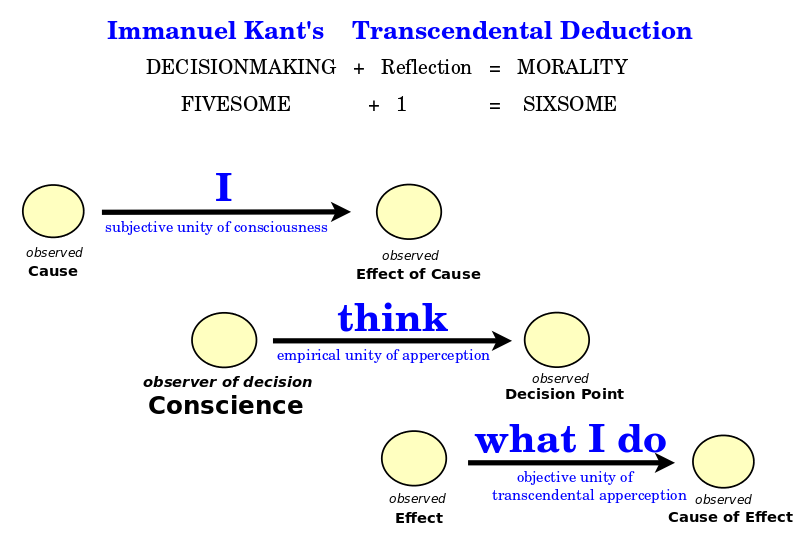
Here all of the perspectives share an observer, and so we imagine that observer as above the other perspectives but focused on our experience of the decision point. In other words, the sixth perspective is our conscience. I believe that the three shifts are interlinked cyclically. As Kant observed in his Transcendental Deduction, we have a threefold accordance between first, our theoretical self, I, which he called the subjective unity of consciousness, and second, our thoughts, which he called our empirical unity of apperception, and which I claim is circumscribed by our conscience's view upon our deciding, and third, what we practically do, which he called the objective unity of transcendental apperception.
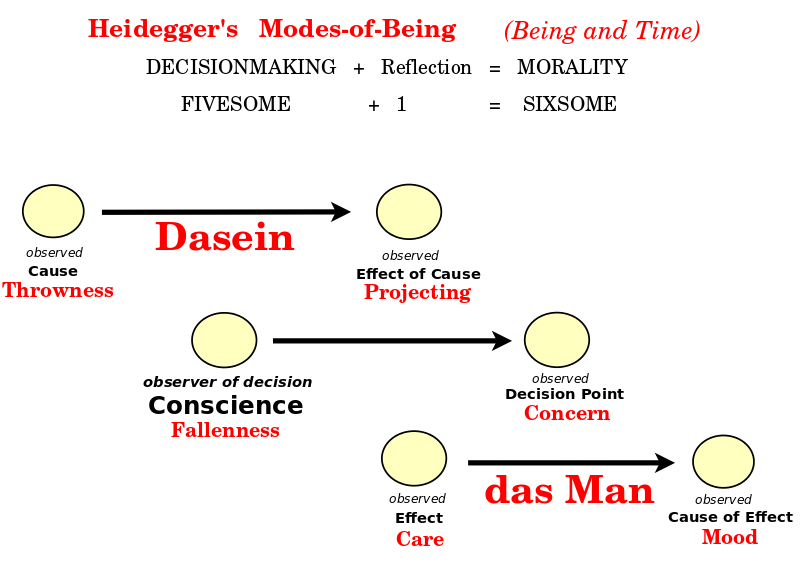
In Being and Time, Heidegger discusses a similar framework in terms of modes-of-being. Both Kant and Heidegger can be understood to support my earlier description of decision-making as consciousness of questions of being.
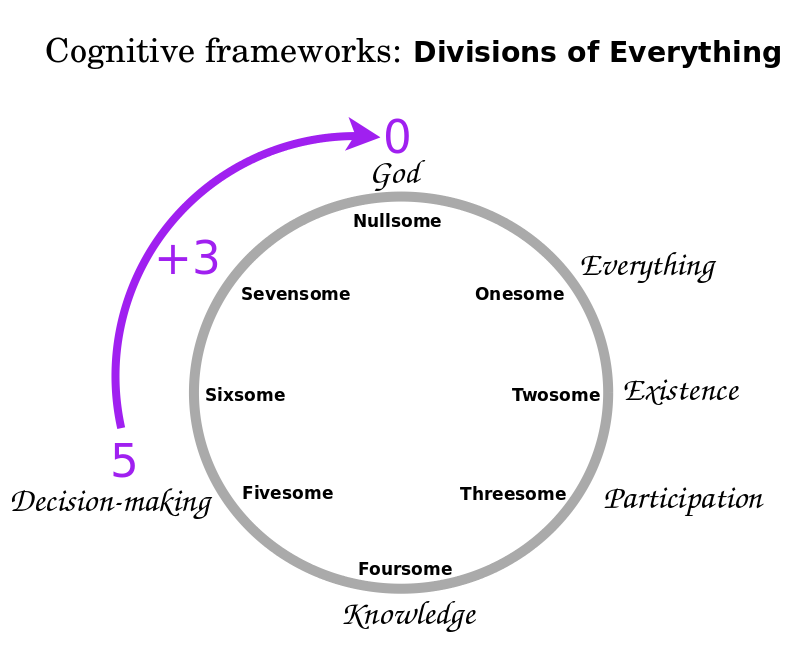
Finally, I will describe how consciousness of decision-making bring us to experience issues of God. Namely, I will show how time and space taken together make the known and the unknown both ambiguous and unambiguous so that all distinctions disappear and we are left with no perspectives, and no expectations, but simply peace, wishing for anything.
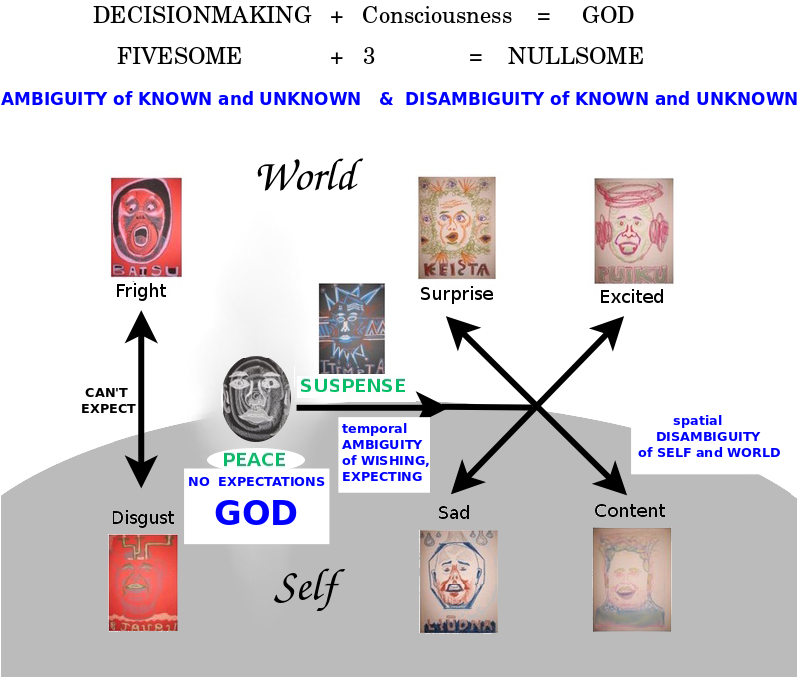
We can model our emotional life as based on expectations and our resulting knowledge. If I expect something and I am wrong, then I am surprised, whereas if I am right, then I feel excited. But if it was profoundly important to me, and I am wrong, then I am distraught, but if I am right, then I feel content. And if it is too sudden for me to make an expectation, and it comes from beyond me, then I feel frightened, but if it is too strange to make an expectation, and it comes from within me, then I feel disgusted. Thus our emotional life marks a boundary disambiguating our self, what we should know, and our world, what we don't know, our feeling of sadness, contentment, and disgust on the one side, and surprise, excitement and fright, on the other side. But before we know the consequences of our expectation we feel suspense, or we simply don't have expectations and feel peace.
Temporally, we live as creatures of not knowing who experience the ambiguity between expecting (and ultimately knowing) and simply wishing and waiting and perhaps never knowing. Spatially, we live as creatures of knowing, who disambiguate the self we know and the world we don't. Taken together, we have both the ambiguity of the known and the unknown but also the disambiguity of the known and the unknown. This makes for a collapse of all distinctions and we are left with no perspectives but simply peace.
This model suggests that time and space must be kept apart so that they play their distinct roles, with time fostering ambiguity before we have knowledge, and space fostering unambiguity after we have knowledge. We also see why time, being ambiguous, might define one free dimension, whereas space, establishing disambiguity, might define three free dimensions, distinguishing the inner self, the outer world and the disambiguating boundary.
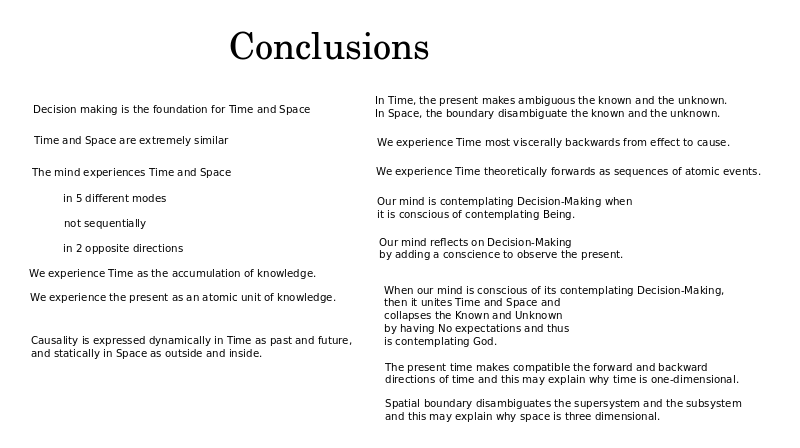
In conclusion, I have presented a system of cognitive frameworks which provide a lot of metaphysical ideas on the nature of time and space. I derived these ideas through thirty-five years of careful introspection, relying also on consideration of ideas from all manner of thinkers, and overall attempting to make sense of all genuine perspectives. However, these ideas can be tested further with tools from experimental psychology, cognitive science, neuroscience and other fields. But they might also be dramatically confirmed if they proved useful in mathematics or physics, explaining, for example, why three dimensions, not more and not less, are especially rich spatially, as we know from the proofs of the Poincare conjecture.
In summary, time and space are very similar and are determined by the five perspectives we need for decision-making. We construct time and space by jumping amongst these five perspectives.
